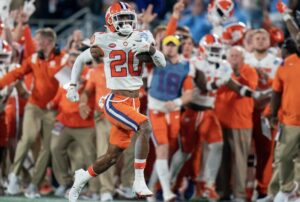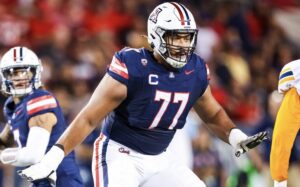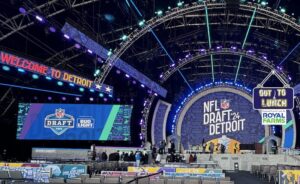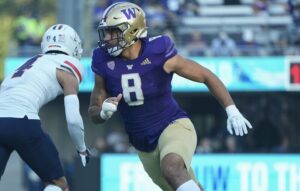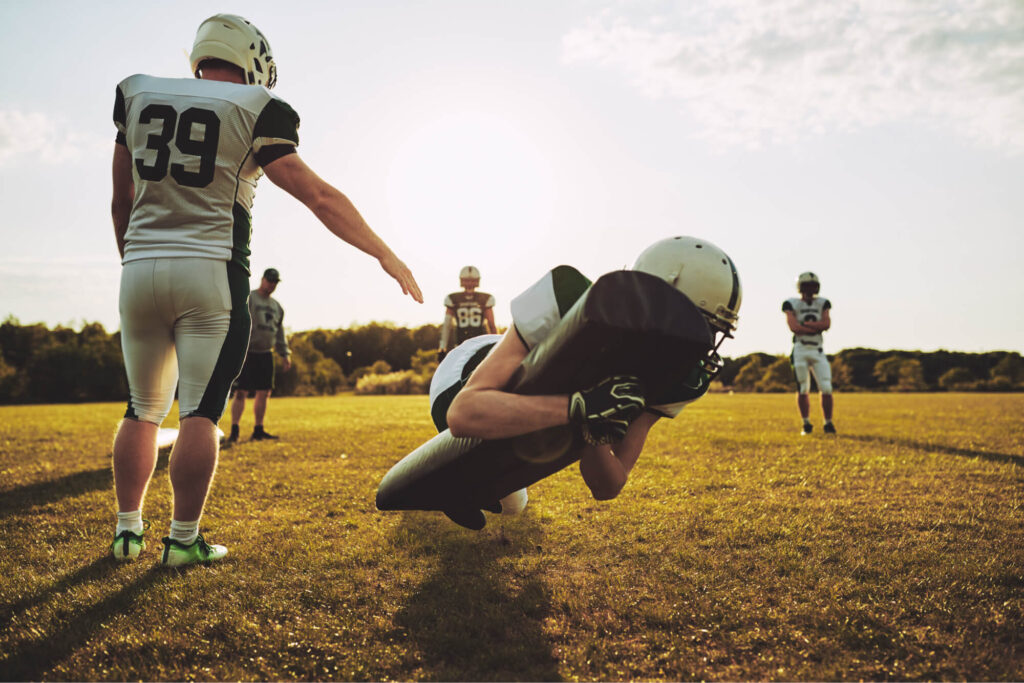This is Part 2 of a three-part series examining the history of the Baltimore Ravens’ strategy and results in the NFL Draft. If you missed Part 1, click here. In Part 2, we look at the Ravens’ drafts under head coach Brian Billick.
1999
The Ravens again have the tenth pick and again they stand pat to draft a cornerback, this one having much better value than Starks – Chris McAlister. McAlister was selected three picks after the Redskins took Champ Bailey, a future Hall of Famer at the same position.
At the top of the second round the Ravens traded away their pick to the Falcons, who used it on tight end Reggie Kelly. The Falcons were emboldened by a 14-2 record in 1998, thinking that if they just beefed up their passing game a bit the Lombardi trophy would be theirs. Instead they would go 5-11 in 1999, giving the Ravens end the fifth pick of the draft in 2000.
Does this line of thinking remind you of 2011, when the Falcons, coming off a 13-win 2010 season, traded two firsts, a second, and two fourths to the Browns to move up six spots to get Alabama wideout Julio Jones — thinking he would put their passing game over the top?
2000
With the pick the Ravens acquired from the Falcons they select Jamal Lewis, who helps them win a Super Bowl as a rookie.
Many pundits called Lewis, who had a history of injuries at Tennessee (and we’d later learn, some questionable business dealings), a reach at the fifth pick. Conventional thinking had the Ravens taking Corey Simon, the defensive tackle who went sixth to the Eagles. However, Ozzie Newsome had just succeeded in luring the mercurial veteran tackle Sam Adams back from the airport to sign with the Ravens hours before the draft. Signing Adams allowed the Ravens to move Lewis ahead of Simon on their draft board.
Lewis played seven years in purple, and was an All-Pro in 2003 when he became just the fifth running back to ever rush for more than 2000 yards in a season (his 2066 yards were just 39 shy of Eric Dickerson’s All-Time record of 2105).
Later in the first round, the Ravens trade up from the 15 spot, using their second round pick, in order to select Travis Taylor with the tenth pick. Not a great move. The Broncos got the 15th pick, which they used on two-time pro-bowler Deltha O’Neil.
It would take the Ravens ten years to even the draft-day-trade score with the Broncos.
2001
The Ravens held the 31st and final pick of the first round after winning the Super Bowl. They stayed put and used the pick on Todd Heap. Great value. But not as good as the players selected one spot ahead of and behind him.
The Colts had been sitting at 22 but traded back to 30, getting extra picks from the Giants, who took Will Allen at 22. The Colts grabbed Reggie Wayne one spot ahead of Heap. With the 32nd pick the Chargers took Drew Brees.
There may never again be three better players taken with picks 30-32.
Heap at the time was not seen as filling a particularly big need for the team, who still had veteran tight end Shannon Sharpe on the roster. However, it was clear that Ozzie was approaching the draft like a chess board, thinking three or four moves ahead.
Heap, of course, went on to become a fan favorite during his ten seasons in Baltimore, and will certainly find himself in the Ravens’ Ring of Honor.
2002
The Ravens stayed put at 24 to take Ed Reed. Like Heap, who was selected to replace a veteran pro bowl talent in Sharpe, Reed would play alongside, and eventually replace, legend Rod Woodson.
The front office was also high on linebacker Napoleon Harris, who went one spot earlier to the Raiders. But rather than trade up to get him, they stayed patient as Reed fell to them. Harris stuck around for nine up-and-down seasons with Oakland, Kansas City, and Minnesota.
This is a case of the best trades being the ones you don’t make.
It is interesting to note that the Saints traded up to 25 to get Charles Grant in this draft. There certainly could have been calls made to Ozzie about getting the Ravens pick at 24. The Saints ended up giving up Ricky Williams and a fourth round pick to Miami, a pick that became Randy McMichael. In addition to getting Grant with the 25th pick, the Saints got a second rounder from Miami and a pick that became Calvin Pace.
Maybe it was the Dolphins who were really the buyers in that deal, targeting Ricky Williams, and the Ravens wouldn’t have factored in offering pick 24. Funny to think the Ravens picked Reed, and later signed Ricky, the guy was part of a draft-day deal one pick later, as a free agent.
Reed is in the discussion among the greatest safeties to ever play the game, and is without a doubt the best “center fielder” in NFL history. Not a bad pick.
2003
This was the crazy draft where the Minnesota Vikings originally held the seventh pick, but skipped their pick, twice, before taking Kevin Williams at nine. Big, dumb Mike Tice sitting there in the war room with his big, dumb face.
However, in retrospect, it wasn’t so dumb. Williams was a staple on the Minnesota line for years.
Still, recall that in the process the Vikings also screwed the Ravens who were trying to trade up to pick seven to get Byron Leftwich. Most versions of the story have the Jags tying up phone lines to the commissioner’s office so that the Vikes and Ravens could not consummate their deal so that the Jags, slotted to pick eighth, could nab the big quarterback for themselves.
Karma is a bitch. Leftwich never really panned out for the Jags, who remain in QB-hell to this day. The Vikings, in the confusion, allowed their turn to slip down to nine as cards were rushed to the podium. They end up with Kevin Williams, the guy they wanted all along, and who ended up being better than the guys picked ahead of him anyway. In addition, the Vikes get Williams for a slightly lower slotted salary figure. Dumb like a fox.
Or is it lucky like a duck?
In retrospect, again, the Ravens did okay when Terrell Suggs fell to them at
pick number ten. Lucky ducks.
Suggs earned his first AP Defensive Player of the Year award in 2011, the third Raven (all of whom were drafted by the team) to win the award.
The Ravens didn’t do so great with their second round pick – which they apparently were itching to dump that year – when they packaged it along with their 2004 first round pick to move up to pick #19 to take Kyle Boller.
How ironically harsh is it that quarterback Kyle Boller was Baltimore’s selection at #19? Nobody ever confused Kyle with Johnny U, that’s for damn sure.
2004
No first round pick. Ugh. Dwan Edwards (selected in the second round) we hardly knew thee.
By the way, the Ravens original first-round pick this year, which they used to move up and get Boller the year prior, was #21. The Patriots used that pick they had acquired from the Ravens to select Vince Wilfork, the man who pretty much single-handedly stopped them from reaching the Super Bowl in 2011. Double ugh.
2005
With the 22nd pick the team selected Mark Clayton. A good-character guy who was too injury prone to ever live up to the expectations that came with being selected so high.
Think about some of the personalities on this offense over the years, like Clayton, Boller, Ed Mulitalo, Heap, Devard Darling, Randy Hymes, Jamal Lewis, Tony Pashos, Adam Terry, Kordell Stewart, Chester Taylor, Anthony Wright. What an odd cast of characters. Head Coach Brian Billick had the right idea when he liked to talk about his offense’s “profile.” He just had the wrong profile.
Anyway, there was apparently some debate about who they should take when the 22nd pick came up, with some on the staff favoring Fabian Washington, who went to Oakland with the next pick. The Ravens end up trading a fourth round pick to get Washington from Oakland a few years later, but he never lived up to what they (or Oakland) had hoped for in him.
Clayton probably won out in the draft room based on thinking that they needed to surround Boller with better talent. Smarter thinking might have been to give up on Boller instantly, and simply taken Aaron Rogers, who went two picks behind Clayton that year to the Packers.
Let that sink in for a minute.
That said, it is hard to make that argument in the real world. Still, just think, when they missed on Leftwich they perhaps pressed too hard to solve the position with Boller. Had they stayed put, and been more patient finding their quarterback, they could have had three straight drafts in 2003-2005 with Terrell Suggs, Vince Wilfork, and Aaron Rogers. Instead it was Suggs, Boller, and Clayton.
And you wonder why Brian Billick would end up losing his job a couple years later.
It may be worth noting that these were the three drafts that Phil Savage had basically architected. Technically, Phil was with the Browns by February of 2005, but the majority of the evaluations for the 2005 draft for the Ravens had gone through Phil already.
2006
In Phil’s second year in Cleveland his Browns were holding the 12th pick, and the Ravens were selecting at 13. In the minds of many, Phil “snookered” his old team into giving up a sixth round pick so the Ravens could move up one spot, and Phil could still take the guy he wanted all along, Kamerion Wimbley at 13.
With the extra pick Phil selected a bargain defensive tackle, the middling Babatunde Oshinowo. The Ravens took the “lazy” Haloti Ngata at 12.
Who really won that deal?
Ngata is one of the best defensive tackles in the game today, while Wimbley has had some success but will still play for his third team in 2012, and Oshinowo hasn’t been on an active roster since 2007.
Recall that this was on the heels of Phil doubly screwing his old team the year prior by stealing the great and powerful Derek Anderson off waivers as the Ravens tried to sneak Anderson onto the practice squad. Sometimes we judge deals too quickly.
2007
The Ravens stayed at #29 to take the recently departed Ben Grubbs. A solid, but not spectacular pick, Grubbs manned the left guard spot more than adequately for five seasons in Baltimore.
Many wanted the team to trade up and get Joe Staley, who has been just as good as Grubbs at the harder-to-fill tackle position for the 49rs. The Niners had already selected Patrick Willis earlier in the 2007 draft, so to get back into the first round they gave the Pats their 2008 first rounder and their 2007 second rounder. That would have been tough for Ozzie to trump.
April of 2007. Maybe this was a case when it would have been better to pay the price, move up a couple of spots, and take care of a need for the foreseeable future.


